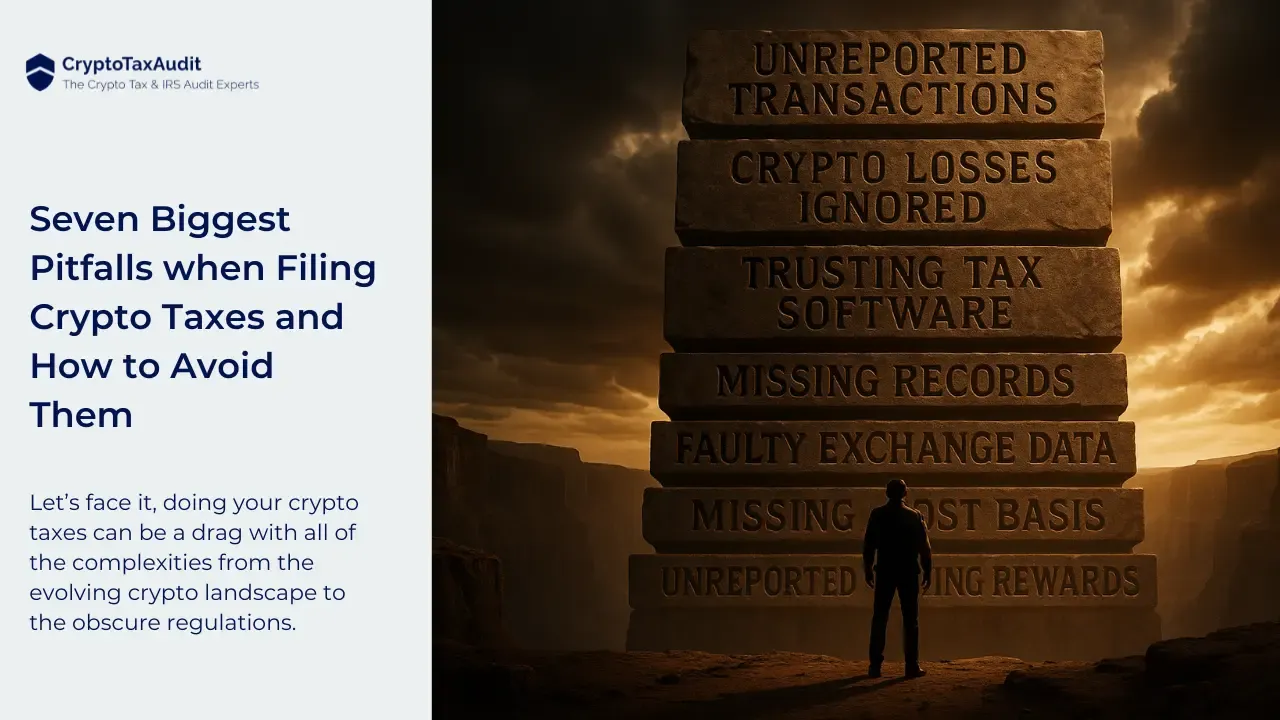
During 2021, the United States, along with many other nations worldwide, saw historic interest rate increases, going from 0.25% in 2021 to the current 5.5% rate since July 2023. This has had a cascading effect on all interest rates, from consumer credit cards to auto loans and mortgages. Among many other interest rates impacted by the Federal Reserve rate increases are the interest rates charged by the Internal Revenue Service (IRS), going from 3% for 2021 to 8% for 2024. For any crypto investors, this means that making sure to make tax payments on time is even more critical than ever before. As we near the April 15 deadline, whether you are extending your tax return or have to pay first-quarter estimates, it is critical to make these payments timely.
Do You Need to Pay Estimated Taxes?
In general, two broad categories of taxpayers that typically need to make estimated tax payments include:
Business owners, from shareholders of S-Corporations and Partnerships to sole proprietors and
Investors (or traders), including crypto and stock investors
These taxpayers have income that does not have tax withholding like traditional W-2 jobs (for S corps, this would include the residual net income at the end of the year). If you have a W-2 job, you will notice that each paycheck has amounts withheld for federal and state taxes (in addition to Medicare and Social Security). As such, W-2 employees (whether salaried or hourly) do not generally have to worry about making estimated tax payments unless they are significantly under-withheld (in which case, we recommend speaking with HR to have your withholding adjusted). Retired taxpayers relying on social security income and retirement distributions can have taxes withheld, and these amounts can be adjusted depending on your tax situation.
This means that the two larger groups of taxpayers that must make estimated tax payments are business owners (including self-employed individuals) and investors. The good news for these groups is that estimated tax payments are due quarterly, four times a year, as opposed to biweekly for most W-2 employees. In a period with high interest rates, this can provide taxpayers with some interest income on their tax money, earned between the time they deposit it into their account and when the payments are made. However, underpaying your estimated taxes comes with steep interest rates, making estimating properly critical.
When Are Estimated Tax Payments Due?
The IRS assumes taxpayers earn income evenly during the year; therefore, estimated tax payments are due quarterly. For individuals, the due dates are:
April 15, for income earned between January - March
June 15, for income earned between April - May
September 15, for income earned between June - August
January 15, for income earned between September - December of the prior year
If your income is not earned evenly, for example, there are alternative options that may be available to help mitigate the penalty.
How Much Should I Pay?
For some taxpayers, knowing the amount that you should pay quarterly is fairly straightforward. For example, a self-employed individual who makes most of their money from consulting services with few expenses can probably calculate the right percentage to pay in a fairly straightforward manner. Simply look at your effective tax rate (i.e., your total tax divided by your taxable income), and make sure to cushion this on the high end to be safe.
Business owners should calculate their estimated taxable income quarterly. If you have good accounting records, this can be simple: take your quarterly P&L, account for any book-to-tax differences (such as depreciation, amortization, etc), and estimate your taxable income for the quarter. Then, make your quarterly payment based on your effective tax rate from the prior year if income is otherwise consistent year over year.
Equities investors and traders tend to have sporadic income, as no one can predict the markets and a strong first quarter can be followed by a bearish second quarter. Keep in mind that payments are on year-to-date taxable income, so in the case of an outstanding first quarter with losses in the second quarter, unless you have other taxable income without withholding, you might owe a large payment for the first quarter only to find out that you don’t have to pay for the second quarter. Always consider all year-to-date income and year-to-date payments to ensure that you are paying the proper amounts for the year. The benefit for investors and traders using traditional brokers is that the brokers will generally keep year-to-date tax records, and obtaining your information can be as easy as going to their tax center or reviewing your quarterly statements.
Crypto investors, on the other hand, may have a mountain to climb when it comes to properly estimating their year-to-date gains and making the proper tax payments. This is because:
Crypto exchanges often do not provide tax records on year-to-date activity. Those that do will have inaccurate information if you transfer crypto into or out of the exchange.
Many crypto investors use decentralized exchanges (DEXs) to trade. While there are many advantages of using DEXs, a huge disadvantage is that none of them will provide you with tax information due to inherent limitations.
Crypto investors and traders, especially during a bull market, tend to trade heavily, oftentimes trading first and then figuring out their taxes months later. The issue with this approach is that high volume and the passing of time both contribute to the likelihood of forgetting a critical piece of the puzzle to correctly compute your taxable gains, such as an exchange or wallet used.
Tax tools like CoinTracking and CoinTracker rely on good data inputs to generate reports. These tools can do an amazing job of consolidating your data and providing such figures. However, if you forget to add a wallet to an exchange, or if there is missing or duplicate data or transactions that you are unsure of how to classify for tax purposes (think liquidity pools and staking), the output from these platforms will not be accurate.
All of the above are reasons why estimating your quarterly taxable gains from crypto can be extremely difficult and time-consuming, even for the best accountants. This leads to the question, is there another way to estimate your tax payments and avoid any penalties and interest?
Avoiding Penalties Safe Harbors
Taxpayers who need to make estimated tax payments can generally rely on one of the two safe harbors to avoid penalties and interest:
90% of Current Year Tax: Paying 90% of the total expected tax for the current year, 2024, means no late payment penalties on the underpayment of estimates will be assessed. This does require you to estimate your year-to-date taxable income and make those timely estimated payments quarterly. Due to the uncertainty of estimating your income, we recommend you overpay your estimated payments to be safe. You can always have the excess refunded or applied to the following tax year.
100% of Prior Year Tax: A much simpler approach is to pay 100% of the total tax shown on the prior year's return in equal quarterly installments. Subject to exceptions, taxpayers whose adjusted gross income for 2023 was more than $150,000 ($75,000 if married filing separately) should pay 110% instead of 100%.
With both approaches, it is important to remain cognizant that there might still be a tax balance due when you file your 1040. For example, if you paid exactly 90% of your current year's tax, in theory, you would have 10% left to pay by April 15. If you based this amount on the prior year's tax, you may have a payment due by April 15 if your income was higher in the current year. Remember that either approach will help to minimize or eliminate penalties related to the underpayment of estimated taxes.
The IRS will assess a penalty on the portion of underpaid tax on a quarterly basis. The current rate of this penalty is 8%, compounded daily.
Extension Payments
U.S. taxpayers have the luxury of being able to file an extension by the unextended due date (April 15) and receive six additional months to file their tax return. This is achieved by filing Form 4868.
Remember that this is an extension of time to file - not to pay. The IRS expects you to pay any tax due by April 15. Even with an extension, any amounts not paid by April 15 will be subject to ‘failure to pay’ penalties and interest.
Many taxpayers who typically file by the April 15 deadline worry about the impact of extending. However, this is a common practice and does not have any negative consequences. Extending allows you to take your time to properly prepare your tax return if it is complex, obtain K-1s that are not issued until summer, and fine-tune your complex crypto gain calculations. Sometimes, the additional time may allow you to get further guidance on controversial tax issues.
If you choose to extend, you should be sure to pay any balances due by the unextended deadline or understand that the IRS will assess additional penalties and interest on late payments.
Impact Of Not Paying Taxes on Time
Why is making estimated tax payments and extension payments so important? When you consider the current interest rate environment, the importance of timely tax payments becomes even more pronounced as it can have a significant impact on your finances. While many in the market expect the Fed to cut interest rates in the near future, we have seen Jerome Powell remain committed to keeping rates elevated to reach their target inflation rate of 2%.
The IRS interest rate stands at 8% for tax year 2024, meaning that the cost of delayed tax payments can be significant. This pertains to the late payment of estimated taxes and the final balance payment due by April 15. This rate of 8% is significantly higher than what many taxpayers had become accustomed to, with rates being as low as 3% during the first half of 2022. What used to be a nominal amount for many taxpayers is now a much more impactful amount, making it much more critical to make your payments on time to optimize your finances.

A key aspect that taxpayers must be mindful of is the penalty for failing to make these payments on time. The IRS imposes a penalty calculated using the federal short-term rate plus 3%. In the current scenario, with a prevailing 8% IRS interest rate, the penalty for underpayment of estimated tax mirrors this rate.
For illustrative purposes, consider a taxpayer who fails to make a $10,000 estimated tax payment. If this amount is subsequently paid in full by April 15, the penalty accrues from the due date of each estimated payment to the date of payment. To simplify the calculation, if we consider the penalty accruing from January 15 to April 15 (90 days), the estimated penalty would amount to approximately $199, assuming a constant rate of 8%. This would have only been about $74 back in 2021, with the IRS underpayment rate at 3%.
On the other hand, taxpayers who opt for an extension must be aware of the implications of late payment of the tax due. In addition to the penalty on the unpaid tax (calculated at the current IRS rate of 8%), a late payment penalty will also be imposed. This penalty is 0.5% per month on the unpaid amount, with a cap of 25%.
To illustrate, if a taxpayer owes $10,000 and opts for an extension, deciding not to pay this amount until October 15, the accrued interest from April 15 to October 15 would be approximately $401. Additionally, the late payment penalty for this period would amount to $305. Therefore, the total amount due, including both interest and penalties, would be approximately $706. If we compare this with 2021, the total penalty and interest back then would have been $455, or about 64% of the current amount.
Remember that these examples are on a $10,000 payment, meaning that crypto traders and investors who have made significant gains and owe much higher taxes could see much more significant penalties. For someone who owes $100,000 by April 15 and does not pay until the extended due date, the total penalties and interest would be $7,060. Considering that $100,000 of tax can be triggered by about $400,000 of gains (approximately as this varies depending on whether the gains are long or short-term), during a bull market, it is easy to see how some investors could get up to these amounts. A bull market combined with a period of high interest rates and complexities in calculating your crypto gains is a perfect recipe for the IRS to boost their interest income. Therefore, it is imperative for taxpayers, especially those with significant tax liabilities, such as business owners and investors, to plan their tax payments diligently and seek professional advice when the estimates become too complicated. If you need assistance, we welcome you to, schedule a consultation with CryptoTaxAudit.
Estimating Taxable Income
So, how do you estimate your tax due if you plan to extend your tax return? In general, you have two options:
- Have a professional calculate this for you, for which you will have to provide all available tax information, including prior year returns. If you choose to go this route, you are welcome to schedule a consultation today.
- Put on your best accountant hat and get to work. Below is a general process you can follow.
Steps to Estimate Your Taxable Income
Disclaimer: These calculations can be complex for taxpayers who are not skilled in preparing tax returns. The information below is for informational purposes only. If you need assistance, schedule a consultation with CryptoTaxAudit.
- Have your last filed tax return on hand, along with all available tax information for the current tax year, such as W-2s, 1099s, K-1s, and 1098s.
- Go to your tax program of choice and start entering all your information as if you were getting ready to file your tax return. DO NOT FILE THIS RETURN!
- Compare your return with your prior year's return, and figure out what missing information you have. Look for items of income and expense that you had last year but are still missing this year.
- If you know that the amounts from the previous year are comparable to last year, we recommend using the amounts from last year, rounded up for additional cushion. Make sure to write down any estimated amounts to ensure you return later and enter the actual amounts.
- If the amounts for the current year are unknown, for example, income from a K-1, we recommend reaching out to whoever issues your K-1 and asking for an estimate.
- Include your gains from stocks and crypto, as well as income, such as airdrops or hardforks, in this estimate. If you don’t have a good number to use for your crypto gains, use a reasonable estimate; a suggestion would be to calculate your gains and losses, focus on the larger gains (and larger loss) amounts, and ensure that these are as accurate as possible, then rounding this amount up by 20% or so to ensure you have some cushion. For example, crypto traders may have 5,000 transactions during the year due to transfers, staking, buying, and selling many coins for a small gain or loss. But a handful of these transactions (selling your Bitcoin at $70k, Solana at $200, or dumping the coin you aped into and turned out to be a rug pull, causing you to lose $10k) will be the main drivers for your gains. Focus on such large transactions and ensure that you round up this amount to avoid surprises. It is always better to have overpaid your taxes than underpaid.
- Once you have all of your sources of income and expenses filled out or estimated, make sure to enter all of your estimated tax payments and W-2 or 1099 withholding. If you do not account for all your payments and withholding, you will be overpaying your extension.
- Your extension payment will be based on the tax due, which is equal to: Total Tax Due for the Year - Total Tax Paid for the Year. In order to be safe, we recommend that you add a 10 to 20% cushion to this payment, depending on how many estimates you used and how confident you are with your estimates.
- As previously mentioned, if you include your first quarter estimated payment amount within your extension amount (i.e., extension payment = amount due at extension + first quarter estimate), you will further ensure that your extension payment covers your entire tax liability. Any overpayment can be applied to the following tax year and will be considered timely, similar to making a first-quarter estimated tax payment.
-
State Tax Considerations
State tax laws can vary significantly by state; as such, it is recommended to consult with your state’s Department of Revenue website to verify requirements. In general, however, many of the concepts applicable to federal taxes also apply to state taxes.
When extending your tax return, you should ensure that your state does not require a separate extension. While most states will grant an automatic extension if you file Form 4868 with the IRS, every state is different, so it’s always best to double-check. In cases where a payment is due to the state, you will have to remit this to the state tax authority separately.
-
Conclusion
This article emphasizes the importance of making your estimated tax and extension payments on time, especially in a climate of rising interest rates. As these rates climb, the financial impact of delayed or missed IRS tax payments escalates correspondingly. This is particularly pertinent for business owners and investors, including those in the volatile field of cryptocurrency, who face a challenging tax landscape. Grasping the specifics of estimated tax payments, understanding safe harbor rules, and recognizing the consequences of tax filing extensions are crucial for effective financial management in today's economic context and can just plain save you money.
Given the detailed and often intricate nature of tax planning, coupled with the potential for significant penalties and interest for inaccuracies, professional advice is more than a convenience—it's a necessity. Our team specializes in providing clear, actionable guidance in these areas. Consider scheduling a consultation with us to ensure your tax strategies are both effective and compliant. We are here to provide expert assistance and help you manage your tax obligations efficiently.





